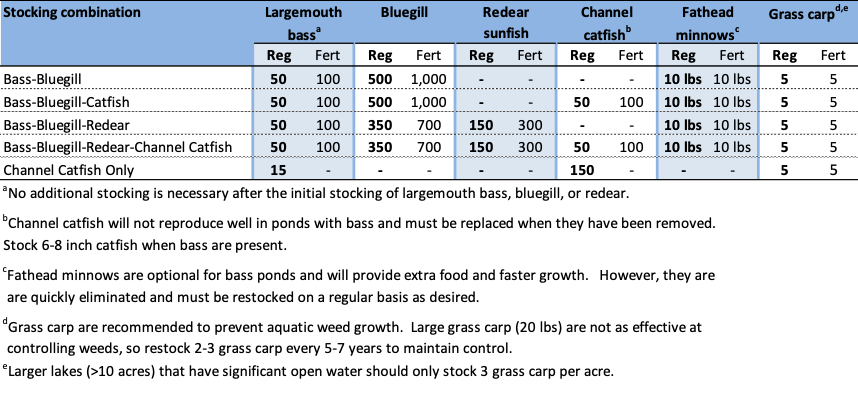Stocking Recommendations for Ponds 1 Acre or Larger
It is important to stock a pond in the proper order and with the recommended numbers to achieve a balanced fish population. For sustained fishing quality, the basic largemouth bass-bluegill combination is the best starting point, and several additional species can be added. To begin, choose the desired stocking combination from the table below and stock those species as follows:
-
Stock fingerling bream (bluegill and redear sunfish), catfish, triploid grass carp, and fathead minnows in the fall or winter. The pond should be at least half full and filling.
-
Stock 500 bream per acre. This can be all bluegill or, if desired, 350 bluegill and 150 redear sunfish.
-
If you want channel catfish in your pond, stock at 50 catfish per acre.
-
Stock five triploid grass carp per acre to avoid weed problems. For lakes larger than 10 acres that have much open water, stock three grass carp per acre.
-
Fathead minnows can be stocked at 3 pounds per acre with bluegill in the fall or winter to provide additional prey (optional).
-
-
Stock 50 largemouth bass per acre the following spring when the bream and fathead minnows are ready to spawn. This ensures that small bream and minnows are available for the small bass.
-
The stocking ratio of bream to bass should be 10:1.
-
Bluegill and redear sunfish fingerlings stocked in the fall and winter will spawn the next spring. Stock largemouth bass fingerlings in the spring to coincide with the first bream spawn. They feed on the small bream, preventing an overpopulation of bream. Fathead minnows provide supplemental winter forage for largemouth bass and bream. If timing is such that you cannot stock the pond in this order, consult a fisheries biologist to discuss an alternative stocking strategy that might work. Since all situations are different, no single recommendation easily applies to all cases.

With the exception of catfish and grass carp, it is not necessary to restock the pond. Adding fish to the pond year after year can lead to overcrowding and stunted fish. This has ruined the fishing in many ponds in Mississippi. With proper management, a correctly stocked pond generally results in a balanced fish population, ensuring good fishing for years to come. You can restock catfish after you remove more than half of the fish from the original stocking. Remember to stock larger (8- to 10-inch) catfish to avoid feeding catfish to your bass in established ponds. Similarly, grass carp become ineffective after 5 to 7 years, and it is a good idea to remove some and stock young fish to replace them.

